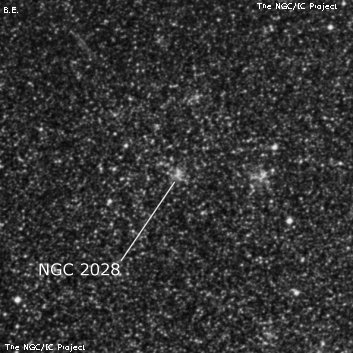
S-L 574 appeared bright, moderately large, slightly elongated E-W, 30" diameter, brighter along the major axis, clumpy. A mag 14 star is at the west tip and a mag 11.9 star is 0.9' SSW. H-S 353 is a fairly faint, soft round glow, 30" diameter. S-L 591 appeared fairly bright, fairly small, roundish, 35", mottled. Only a couple of mag 16 stars resolved around the edges. A mag 11.8 star is 1.7' NE. H-S 362, just 2' ENE of S-L 591 is fairly faint, elongated NW-SE, 25" diameter. It forms the eastern vertex of a equilateral triangle with S-L 591 and the mag 11.8 star.
John Herschel discovered NGC 2028 = h2912 on 12 Nov 1836 and simply noted as "vF". His position is an excellent match (he corrected his RA by 10 sec) with cluster S-L 575, so the identification is certain although I'm surprised he apparently missed nearby S-L 574, which is equally as prominent. JH questioned if his object might be D 100. Dunlop's description reads "a small round nebula, about 2' north of a small star." His position is just 2' NW of S-L 575 and 3.4' NE of a mag 11 star (his small star?). But D 100 is also 10' ENE of NGC 2016, so it could be also be D 100 given his range of positional errors. Neither Steinicke nor Glen Cozens equates D 100 with NGC 2028.
600/800mm - 30" (10/14/15 - OzSky): fairly bright, moderately large, roundish, high surface brightness, mottled, a couple of stars resolved at the edges. A small partially resolved clump is just off the northeast side. In a small trio with similar S-L 574 2.4' W and fainter H-S 353 2.2' NNW. NGC 2028 is within association LH 80, a stunningly rich region of the LMC with NGC 2016 11' W, S-L 591 6' NE, H-S 362 is 8' NE, NGC 2036 8' SE and more. A group of 4 mag 14 stars is 2' E.
Notes by Steve Gottlieb